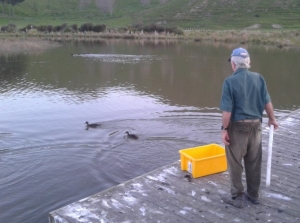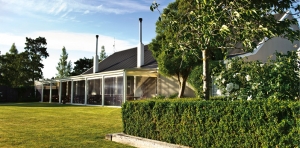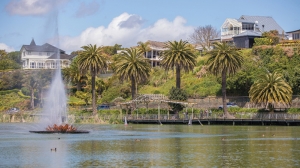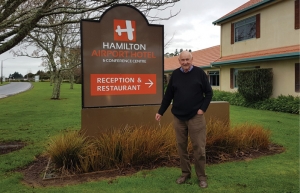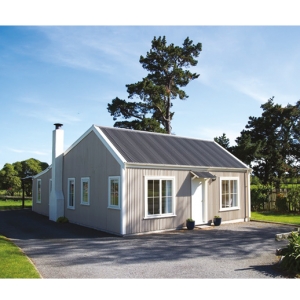Displaying items by tag: Conference
Land of the First Light
For this year’s annual conference and AGM, Ducks Unlimited members will head east to Gisborne, land of the first light.
The venue for the conference, being held on 31 July and 1 August, will be the Emerald Hotel in the heart of the city.
A treat is in store for the field trip, with Nick’s Head Station in Muriwai agreeing to let delegates and their guests visit its wetland on Saturday, 1 August. Organisers are arranging for three speakers during the wetland visit.
They are:
- Kim Dodgshun, manager of Nick’s Head Station – welcome and introduction
- Steve Sawyer, owner/operator of EcoWorks, which implements many conservation activities at Nick’s Head
- Sandy Bull, a driving force behind much of the conservation work in Gisborne.
Nick’s Head Station is by the ocean so an alternative may be required if the weather does not allow the visit to go ahead as planned.
At this stage it is suggested to have the speakers at the Knapdale Eco Lodge if the weather is too bad.
Knapdale is somewhat protected in poor weather so it may be possible to view the wetlands there instead.
But, with Gisborne having the second highest sun hours in the country, conference organisers are hopeful DU can visit Nick’s Head Station.
AGM Conference and reports
This year’s Ducks Unlimited New Zealand’s 45th conference was held at the Collegiate Motor Inn in Whanganui, with just over 50 attendees. The weather was kind and, after a bitterly cold, wet and windy Friday, turned on the sunshine in time for the field trip on Saturday, 3 August.
President Ross Cottle opened proceedings at the AGM by saying it had been a reasonably quiet year, with only three members’ wetlands being developed, however work at Wairio Wetland was going well and good progress had been made.
He paid tribute to long-time DU supporter and Wairarapa Chapter Secretary/Treasurer Joyce Brooks who passed away shortly after the previous AGM.
Treasurer John Bishop, after his traditional warm-up joke, presented his report. He confirmed and reviewed the requirements of being a charitable trust, which include providing a mission statement, entity structure and a yearly report of income, expenditure, activities and volunteer support.
The information for the Charities Register notes DU is reliant on volunteers, with about 8000 volunteer hours a year spent on wetlands assessment and building, swan collection, and advice, education, field days, bittern project, supplying magazine content, Wairio planting and education, supporting schools, fundraising, auctions and dinners.
After running through the financials, which show a slight deficit for the year, John concluded:
“We are remain solvent, through support from membership subscriptions, auctions, grants from the Wetland Care Trust, and donations from Treadwells, Pharazyn Trust, Muter Trust, South Wairarapa Rotary and one-off grants.”
Election of Officers
The DU Board remained unchanged, with the two directors whose two-year terms were up, Jim Law and John Dermer, being re-elected unanimously.
Waterfowl and Wetland Trust
David Smith reported that the trust was in good shape thanks to the sharemarket, and despite paying out $40,000 to DU, was in a similar financial position as it was at the end of 2017.
He said the trust was doing exactly what it was set up to do: provide money to enable DU to carry on its work.
Wetland Care
Will Abel said that in line with the previous couple of years, there had been few applications for new projects, with most of the wetland creation activities centred on the Wairio Wetland.
A large wetland in Pahiatua that DU committed $5000 to three years ago had been completed, and in Masterton, DU had helped created another large wetland, to which it contributed $4000.
Royal Swan
Will Abel said it had been a disastrous year for the royal swan, with no cygnets available and even the wildlife centre at Peacock Springs, Canterbury, the usual source of swans, was looking for some new breeding stock.
“We have no idea why really, but anecdotally I suspect it is because it coincides with the 50th anniversary of the moon landing,” he said, tongue in cheek.
“If it improves next year, my supposition will be proved correct, and I will present a paper at the next conference on it.”
He said it was fortunate that there had not been many requests for swans.
Whio
Peter Russell reported that the breeding programme had had a good season, with 65 whio reared from captive pairs and 15 reared from wild clutches. A total of 72 were released.
In the North Island, 30 were released. Three older birds from last season were released on the Whakapapanui in December, and 12 birds, six males and six females, were released at Blue Duck Station in January.
The third release, on the Manganui a-te-Ao, was in early March, with eight males released at the Ruatiti Domain and four females released down the river where there was a surplus of males. Three male birds were released on Mangawhero stream on 20 March.
Peter said it was always a great thrill to take part in the releases out on the river. He has been doing them since 1997 and it has changed so much. In 2000 they released seven, compared with 72 in the past year.
In the South Island, 20 birds were released on the West Coast in January in the Wainihinihi, Arahura, Styx and Kawhake rivers; 12 birds were released on the Taipo River in March; in Tasman 10 birds were released.
Membership
Paul Mason reported that DU currently had 280 members, with 57 of those unpaid as at the AGM.
He said a second subs reminder would be sent out, following email and postal reminders subsequent to the initial subs mailout.
He noted that in the past three years, payment preferences were moving from cheque to internet banking. Credit card payments remained about the same and PayPal transactions were increasing.
More members were responding to the suggestion that DU communicated with them more by email, he said.
Website
Paul said new articles were added as events occur, with the most recent being the planting day at Wairio Wetland. Flight magazines, from No 155 to the current issue, have been loaded on to the site. Issue 29 has also been scanned and added as a PDF file.
Articles from more recent Flight magazines are being transcribed and loaded as searchable items – so far back to issue 159. Old issues are being scanned and loaded as PDFs.
He noted a drop-off in website visitors in the past three months and in response had upgraded the site-mapping software and re-registered the site with search engines.
The main files being downloaded were Flight magazines and people were also accessing the educational resources files (from Quack Club), he said.
Wairio Wetland
Jim Law reported that the wetland was in good heart, benefiting from continued restoration work, albeit at a more modest cost to DU ($4455 versus $9500 in the prior year). Work focused on more bund wall improvements ($1700), tree planting ($2000) and noxious plant control ($755).
At last, significant progress was made by the Greater Wellington Regional Council to reticulate water from Matthews Lagoon and Boggy Pond to Wairio. Earthworks have been completed but after a “weather event”, remedial work is required. This will be done this summer.
“We had provisionally budgeted to fund a portion of this work but GWRC assumed full responsibility,” he said.
Total expenditure by the Wairio Restoration Committee, not counting volunteer time, since inception 14 years ago, now stands at $220,000.
The Victoria University of Wellington School for Biodiversity and Restoration Ecology remain focused on their research at Stage 3.
The Restoration Committee is still holding funds (lodged with DU) from fundraising efforts totalling $10,807. A further $15,000 grant was recently received by local donors. These funds are also being held by DU on behalf of the project committee.
As mentioned last year, Wairarapa Moana, which includes the Wairio Wetland (administered by DOC on behalf of the Crown), has been included in a Treaty of Waitangi settlement with Wairarapa iwi. “Whilst the settlement has been delayed, the local iwi has assured us that they want us to continue our good work restoring the Wairio Wetland.
“We remain of the view, though perhaps slightly biased, that DU members should be proud of this project,” Jim said.
Scholarships
Jim Law reported on DU’s new initiative offering scholarships to students doing research in a relevant area. A trial offering a total of $25,000 over three years in grants of $5000 per student so far had had little response to date.
Four universities had been approached and it was likely the first recipient of one of the $5000 grants would come from Victoria University working on the Wairio site.
AGM venue – a right cracker
Conference 2019 – save the date
Planning under way
Planning for this year’s conference and AGM, which will be held in Wanganui/Whanganui from 2-4 August, is well under way.
The conference venue and accommodation will be the Quality Inn Collegiate, a five-minute walk from the city centre.
The programme will include a field trip to Bushy Park Homestead and Wildlife Sanctuary, with lunch at the category-1 heritage-listed Bushy Park homestead, built in 1906.
The trip will include a stopover at Virginia Lake, pictured, where DU released a number of mute swans several years ago.
Bushy Park is considered by Forest & Bird to be among the 25 best restoration ecology projects in Australasia.
The sanctuary is home to hihi (stitchbird), tīeke (saddleback), toutouwai (North Island black robin), kereru and many other species.
A revegetation project in the wetland area of the park includes plantings of rimu, pukatea, mahoe, karamu, hangehange, pigeonwood, kawakawa, NZ flax and toetoe.
Time to clear out the cupboards
For this year’s conference, DU directors are asking members for donations of suitable auction and raffle items, particularly DU Canada merchandise that you have bought at previous auctions and are in good condition.
Canada DU items have become too expensive to import because of the shipping costs.
Email Will Abel (This email address is being protected from spambots. You need JavaScript enabled to view it.) to let him know what you can contribute to make this year’s auction the best yet.
You can either bring the item/s to conference or drop them off with someone who is going, but please let Will know in advance.
Waipa wars – from muskets to mustelids
CONFERENCE REPORTS
Neil Candy reported that Jim Law had replaced Ken Cook as a trustee on the Waterfowl and Wetland Trust, which was “ticking along really well” with more than $500,000 in the bank.
Wetland Care
Reporting on the work of Wetland Care, Will Abel said $10,800 had been spent on three wetlands in the past year, creating about 10 acres of wetland
BITTERN
WAIRIO WETLAND
Decisive year ahead for Board
Where to from here will be the big question facing the DUNZ Board in the coming year. President Ross Cottle, in opening the formal business of the 44th AGM, said that, with an ageing membership and fewer members keen to do the work, the future direction of Ducks Unlimited would be on the Board’s agenda this year.
Measures already in place or under consideration were making Flight a two-yearly publication and changing the conference to a biennial event rather than yearly. With fewer demands to create new wetlands and maintain the established ones, the Board would be looking at other ways, including research scholarships, to support DUNZ’s goals.
Ross thanked John Cheyne, who resigned earlier in the year, for his four years as president and for raising the profile of bittern. Ross also paid tribute to those members who had passed away during the past year: Ian Pirani, Nancy Pain, Audrey Pritt, Alan Wilk and Robin Borthwick. Joyce Brooks also passed away after the AGM.
Treasurer John Bishop presented the accounts and updated members on the new rules for charitable trusts, which require entities to state their purpose. DUNZ had submitted the following mission statement: “We deliver and advocate for effective wetland restoration, development, research and education; and support the preservation of threatened waterfowl and the ethical and sustainable use of wetlands.”
AGM 2017
Brackenridge Country Retreat is our place for this year’s Ducks Unlimited Annual General Meeting,


(5&6 Aug, also Friday evening if you arrive on the 4th) annual dinner and the much anticipated auction. DU was there in August 2014 and members found Brackenridge enjoyable and comfortable.
The weekend event includes a catch-up on Friday evening, the annual AGM the next morning, plus morning tea then a bus trip to visit Wairio Wetlands, which has come on leaps and bounds since our last tour there. Put in a pair of gumboots for Wairio. Lunch follows at the Village café in Martinborough. Brackenridge has the atmosphere of early New Zealand station dwellings and with a view of the Haurangi ranges. Brackenridge Conference Manager Leeann O’Neill said they are looking forward to hosting our group. All members should receive the brochure about events at the AGM, and the information. Brackenridge can accommodate 64 guests, so make sure you do not miss out.
Accommodation
• Studios, two-bedroom cottages with two bathrooms and fourbedroom cottages with three bathrooms (includes self-catering continental breakfast provisions with free-range eggs).
• Indoor heated 20m lap pool, and gym complimentary for guests (16 years and over).
• On site day spa offering therapeutic and beauty treatments (bookings essential).
• Some unites are available at The Claremount in Martinborough for overflow.
Register now for another fun DUNZ AGM.
Brackenridge
White Rock Rd Martinborough
This email address is being protected from spambots. You need JavaScript enabled to view it.
www.brackenridge.co.nz
Ph: 063068115
Fax: 063068119

